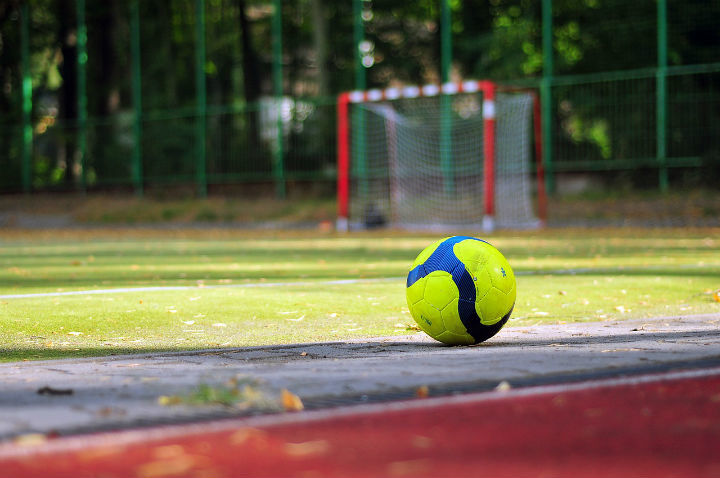How to do a Soccer Throw In Correctly (6-Step Guide)
Despite being a relatively small part of the game, knowing how to execute the perfect throw in with power and accuracy is a useful skill for a player to have.
Since each team is assured to get at least several throw-ins each game, you need to be good at them to retain possession and potentially threaten the opposition’s penalty box.
A sloppy soccer throw in can gift the opposition possession and may even result in your team conceding a goal.
This happening is inexcusable as it’s a relatively simple skill to perfect if a player is willing to follow a few simple steps.
Here’s a 6-step guide that will have you throwing the ball in like a pro:

Mastering the Basic Soccer Throw In
Step #1 - Place Your Hands on the Ball Correctly
It may sound simple, but how you position your hands on the ball is very important.
You want your hands to be in exactly the same place on opposite sides of the ball.
To help get more elevation and distance, your thumbs should almost be touching as this will help you catapult the ball forward when you launch it.
With the ball behind your head, your elbows should be pointing outwards while your hands firmly clasp the ball.
Step #2 - Position Yourself on the Sideline
For the soccer throw in to be legal, you must throw the ball back in from the same place the ball went out of play.
Your feet should be positioned behind the line (or touching it) but cannot cross the line when you move to throw the ball in.
Also, both feet need to be touching the ground when you launch the ball onto the pitch.
With a standing throw, both of your feet will be side-by-side.
If you want a run up, approach the sideline from a few feet back before running up and throwing the ball into play. In this case, most players plant one foot on the ground after their run and then drag their other foot forward as this helps them to chuck the ball further.
Step #3 - Lean Back to Generate Power
By arching your back slightly on the throw in, you’ll generate more power than if you just used your arms for power and nothing else.
As always, your body works as a machine…
The movement of your arms, back, shoulders, and legs will produce far more power than if you use your arms in isolation.
With a run up and this ‘full body’ technique, you’ll be able to throw the ball impressively far.
Of course, if you only need to take a short throw in to a close teammate, then a run up or leaning back may not be necessary.
Step #4 - Launch the Ball Over Your Head
With the ball gripped in your hands behind your head, you now want to throw the ball forward.
Feet firmly on the floor, bring your arms and hands forward while using your body’s forward momentum before releasing the ball over your head and following through with your arms.
Remember: For a throw in to be legal, the ball needs to start behind your head.
Step #5 - Flick Your Wrists on the Release
When launching the ball, keep your head up and eyes looking in the direction that you're throwing even after you've let it go.
This will help to keep the throw accurate.
For a short throw, a small movement to bring the ball above your head and a small wrist flick will be sufficient to complete the throw in.
For a longer throw, let go of the ball as it passes over your head while flicking your wrists to give the ball more power.
Step #6 - Enter the Pitch and Take Up Your Position
After executing the throw, quickly get back on the pitch and either take up your original defensive position or move into an area that will help your team advance up the field.
Also, keep in mind that you can’t touch the ball after you’ve thrown in until another player has touched it.

Soccer Throw In Rules to Remember
There are a number of ways that a throw in can be deemed illegal so it's a good idea to know all the throw in rules right from the start.
They're easy to remember and will help you avoid committing a foul throw.
For a throw-in to be legal you need to:
- Be facing the pitch directly or at a slight angle.
- Have both of your feet on or behind the line.
- Have both feet touching the ground.
- Have both hands on the ball.
- Make sure the ball starts behind your head and is released above or over your head.
In addition to this…
- You can’t score from a throw in.
- A keeper may not pick up the ball from a throw in.
- The player who threw the ball can’t be the first to touch the ball after it’s re-entered the field of play.
Simple, right?!
Now that you know the rules and have mastered the basics of the throw-in, here are a few ways to make your throw ins even more effective...
Taking Your Throw Ins to the Next Level
Tip #1 - Aim the Ball Accurately to Your Teammates
Aim is key when taking a throw in.
You need to make it as easy as possible for your teammate to control the ball when they receive it from one of your throws.
While you normally want to aim so they can take control with their feet, there are some situations that arise during a game that warrant a different approach…
For example, you may want to set it up for a teammate to header if they can flick it on to another member of the team.
Or, if your teammate is tightly marked, it may be a better option to aim for their chest which will allow them to use their body to control the ball while shielding it from the opponent.
Tip #2 - Pick Your Target Wisely
Unless you have a truly monster throw, thrown-ins are rarely a great opportunity to hurt the opposition.
Correctly deciding where and when to throw the ball is an important aspect that will decide whether your team gets an advantage.
Ideally, you want to throw the ball to a player who is darting into an open space as they’ll be less likely to have a defender marking them tightly.
Stationary players who wait for the ball to arrive are inviting pressure on themselves so if you throw the ball to them you risk losing the team possession.
That is, unless you’re throwing to a player who has the skills to control the ball while holding off their defender at the same time.
Tip #3 - Use a Run Up to Get More Distance
As we talked about earlier, a short run up will help you launch the ball a lot further.
Take a few steps back, run towards the line, plant one foot behind the line while dragging your back foot along the ground, and then launch the ball as far as you can.
But always remember that you need both feet on the ground when you release.
Tip #4 - If No Options, Throw Down the Line
Occasionally, you’ll find that a throw in to a teammate will be too risky…
Either because they’re too tightly marked or because you’re too close to your team’s penalty area and don’t want to risk giving up possession.
In this scenario, the best thing to do is launch the ball as far up the wing as possible towards the opposition’s goal.
While a controlled throw-in to a teammate is preferable, this option alleviates the pressure on the team and means you won’t risk losing the ball too near to goal.
Tip #5 - Hide Your Intentions
An advanced soccer throw in tip is to mask your intentions by the way you position your body and the run up you take.
For example, you can make it look like you’re going to lob the ball up field before quickly turning and throwing the ball back to a defender.
But, make sure you’re still throwing the ball in legally.
Conclusion:
Soccer teams need to make the most of every opportunity.
This includes giving your team an advantage from a soccer throw in whenever possible.
Whether you want to make a quick (and legal) throw in to a teammates feet or launch the ball forward for a striker to get a head on it, this 6-step guide and the accompanying tips will help.
If you follow this advice and practice soccer throw in drills regularly, you’ll be able to throw the ball in a variety of ways and you’ll also increase the power and accuracy of your throw.

